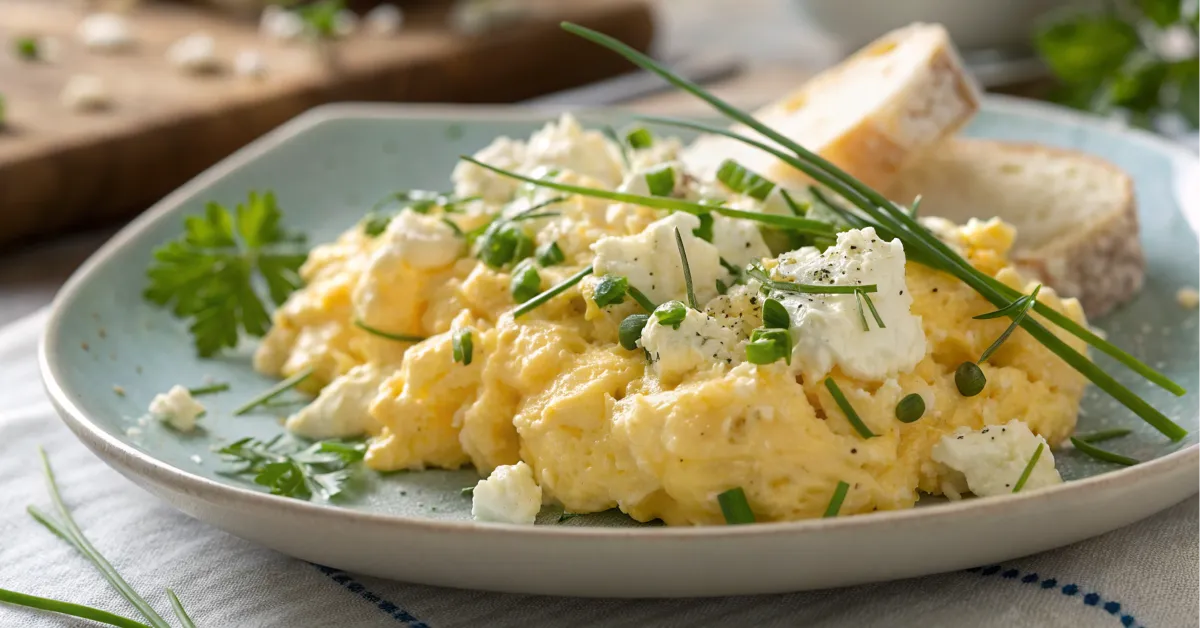Why put cottage cheese in eggs? This simple addition is a game-changer for making scrambled eggs fluffier, creamier, and more protein-packed. Chefs and home cooks love this trick because it enhances texture, boosts nutrition, and adds a subtle, rich flavor. Whether you’re looking to improve your cooking, try something new, or create a more satisfying breakfast, adding cottage cheese to eggs is the upgrade you need. Let’s explore why it works, how to make it, and tips to perfect the recipe.
Table of contents
Why Cottage Cheese and Eggs Are the Perfect Pair
Enhanced Texture and Fluffiness in Cottage Cheese Eggs
Cottage cheese adds a creamy texture to scrambled eggs, making them soft and fluffy. Its natural moisture works into the eggs, preventing them from drying out. Unlike milk or cream, which can thin out the mixture, cottage cheese blends seamlessly without altering the consistency. When cooked, the result is velvety eggs that feel indulgent yet light.
For instance, if you’ve ever found scrambled eggs too dense or rubbery, cottage cheese fixes that problem. Using small curd cottage cheese ensures that it melts evenly into the eggs, creating a dish that’s smooth and luxurious. Even beginner cooks will notice how much easier it is to achieve restaurant-quality scrambled eggs with this technique.
Packed with Protein
If you’re looking for a way to increase protein in your meals, adding cottage cheese to eggs is a great option. Eggs are already a powerhouse, providing about 6 grams of protein per large egg. Cottage cheese contributes an additional 3 grams per tablespoon. Together, they create a dish that fuels your morning, supports muscle recovery, and keeps you feeling full for hours.
For people with active lifestyles, this combination is especially beneficial. Athletes and fitness enthusiasts often rely on high-protein breakfasts to jumpstart their day. Even if you’re just trying to stay energized through a busy schedule, these eggs can help.
If you’re curious about other protein-rich combinations, our guide to cottage cheese pairings offers plenty of inspiration for your next meal.
Balancing Flavors in Cottage Cheese and Eggs
Cottage cheese has a mild tanginess that complements the richness of eggs. This balance prevents the dish from being too heavy or plain. It creates a depth of flavor that’s both satisfying and versatile. You can customize it with herbs like parsley, chives, or cilantro to elevate the taste further.
For those who enjoy experimenting, you can mix in spices like paprika or turmeric to add color and subtle heat. Moreover, these little tweaks make the dish more exciting and ensure it never feels boring.
How to Make Cottage Cheese Scrambled Eggs
Making scrambled eggs with cottage cheese is quick, easy, and incredibly rewarding. Additionally, the recipe requires only a handful of ingredients and a few minutes of your time. Therefore, here’s a detailed guide to get it just right.
Ingredients
| Ingredient | Amount | Notes |
|---|---|---|
| Eggs | 2 | Large |
| Cottage Cheese | 2 tbsp | Small curd preferred |
| Butter or Oil | 1 tsp | For cooking |
| Salt and Pepper | To taste | Optional seasonings |
Step-by-Step Instructions
- Whisk the Eggs
Crack two large eggs into a mixing bowl. Whisk them thoroughly until the yolks and whites are completely combined. A well-mixed base is key to achieving consistent texture when cooking. - Add the Cottage Cheese
Gently fold in two tablespoons of small curd cottage cheese. Stir until the cheese is evenly distributed. Avoid overmixing, as this can break down the curds and make the mixture watery. - Heat the Pan
Place a non-stick skillet over medium heat. Add a teaspoon of butter or oil and let it melt, ensuring it coats the entire pan. This prevents the eggs from sticking and adds a rich flavor. - Cook Slowly
Pour the egg mixture into the skillet. Let it sit undisturbed for about 30 seconds, allowing the bottom to set slightly. Use a spatula to gently fold the edges into the center, then repeat this motion until the eggs are soft and creamy. - Season and Serve
Remove the skillet from heat while the eggs are still slightly moist. Season with salt and pepper to taste. Serve immediately alongside toast, avocado, or fresh fruit for a balanced meal.

Common Mistakes and How to Fix Them
Even with a simple recipe, there are a few common mistakes that can affect the results. Therefore, here’s how to avoid them and ensure your cottage cheese scrambled eggs turn out perfect every time.
Mistake #1: Using Too Much Cottage Cheese
While cottage cheese is essential for the creamy texture, adding too much can make the eggs watery. Stick to the recommended ratio of two tablespoons per two eggs. This balance ensures the eggs stay fluffy without excess moisture.
Mistake #2: Overcooking the Eggs
Scrambled eggs cook quickly, and leaving them on the heat for too long can result in a dry, rubbery texture. Use medium to low heat and remove the eggs from the skillet when they’re still slightly undercooked. They’ll finish cooking from the residual heat, giving you a soft and creamy result.
Mistake #3: Skipping the Whisking
Properly whisking the eggs ensures a smooth and consistent mixture. Otherwise, skipping this step or not whisking enough prevents the yolks and whites from blending properly. Consequently, this can lead to uneven cooking and lumps in the final dish.
For more creative breakfast ideas, try our egg drop sandwich recipe. It’s another great way to reinvent your morning meal.

Tips to Customize Your Scrambled Eggs
Add Vegetables
Mixing in vegetables like spinach, tomatoes, or mushrooms can boost the nutritional value of your scrambled eggs. Sauté the veggies in the skillet before adding the egg mixture for extra flavor and texture.
Try Different Cheeses
While cottage cheese is the star here, other cheeses like ricotta or mascarpone can offer a sweeter, creamier finish. If you prefer sharper flavors, try grated cheddar or Parmesan.
Play with Spices
Spices like garlic powder, cumin, or turmeric can add depth to your scrambled eggs. Turmeric, in particular, provides a beautiful golden color and an earthy flavor that pairs well with cottage cheese.
Serve with Toppings
Garnish your eggs with fresh herbs, avocado slices, or a dollop of salsa. Additionally, these toppings add variety and make the dish visually appealing.
Pro Tips & Variations
Cottage cheese scrambled eggs offer endless possibilities for customization. Whether you want to boost the nutritional value or enhance the flavor, there are many creative ways to adapt this dish. Here are some expert tips and exciting variations to make your scrambled eggs even better.
1. Add Vegetables for Extra Nutrition
Incorporating vegetables into scrambled eggs is an easy way to make your breakfast healthier. Vegetables like spinach, cherry tomatoes, and bell peppers add vitamins, minerals, and fiber to your meal. For a heartier option, sauté mushrooms or zucchini before adding the eggs to the pan.
- Pro Tip: Avoid watery vegetables like cucumbers or raw tomatoes, as they can make the eggs soggy. Instead, lightly cook the vegetables to remove excess moisture.
2. Explore Alternative Cheeses
Cottage cheese works beautifully in scrambled eggs, but you can also experiment with other cheeses. Ricotta adds a soft, creamy texture, while feta offers a tangy flavor. If you prefer a stronger taste, try sharp cheddar or Parmesan. Each cheese creates a unique flavor profile, so feel free to mix and match.
3. Add Spices for Extra Flavor
Spices can make your scrambled eggs stand out. A pinch of turmeric gives a warm, earthy flavor and a vibrant color. Garlic powder is another great addition that complements the tanginess of cottage cheese. If you like heat, sprinkle in some chili flakes or cayenne pepper.
- Pro Tip: Blend spices into the egg mixture during whisking to ensure even distribution throughout the dish.

4. Serve with Protein-Rich Sides
Pairing scrambled eggs with protein-rich sides creates a balanced meal that keeps you full for hours. Additionally, smoked salmon, turkey sausage, or grilled chicken make excellent choices. For a vegetarian option, consider serving the eggs with black beans or roasted chickpeas instead.
5. Use Fresh Herbs
Fresh herbs add a burst of flavor and elevate the presentation of your dish. Dill, parsley, and chives are classic options that work well with scrambled eggs. Sprinkle them on top right before serving for maximum flavor.
FAQs: Common Questions Answered
Here are answers to some frequently asked questions about adding cottage cheese to eggs. These tips will help you make the perfect dish.
Why do people add cottage cheese to eggs?
Cottage cheese adds creaminess and fluffiness to scrambled eggs, making them more satisfying. It also boosts the protein content, making this dish a healthier and more filling option. Additionally, cottage cheese enhances the flavor without overpowering the eggs.
Why are my eggs watery when I add cottage cheese?
Watery eggs usually occur when too much cottage cheese is added. Stick to the recommended ratio of two tablespoons of cottage cheese per two large eggs. Also, whisk the cottage cheese thoroughly into the eggs to prevent uneven texture.
What does Gordon Ramsay put in his scrambled eggs?
Gordon Ramsay’s scrambled eggs are famous for their creamy texture. He uses butter, crème fraîche, and chives to create a rich and velvety dish. While he doesn’t use cottage cheese, the same low-heat, continuous-stirring technique can be applied to this recipe for similar results.
What to add to eggs to increase protein?
Adding cottage cheese is one of the simplest ways to boost the protein content of scrambled eggs. Other options include Greek yogurt, shredded chicken, or tofu. These ingredients make your dish more nutritious while keeping it light and flavorful.
Can I use flavored cottage cheese?
Yes, flavored cottage cheese can work well, but stick to savory varieties like chive or onion. Avoid sweet flavors, such as pineapple, which may clash with the savory taste of the eggs.
Is this recipe suitable for low-carb diets?
Absolutely! Scrambled eggs with cottage cheese are naturally low in carbs and high in protein, making them ideal for keto or other low-carb diets. Furthermore, pairing them with avocado or sautéed greens creates a complete low-carb meal.
For more insights into the health benefits of cottage cheese, explore our article on whether cottage cheese is healthy. It’s a great resource to learn how this ingredient fits into a balanced diet.

Creative Serving Ideas
This recipe is versatile enough to enjoy in many different ways. Here are some ideas for serving scrambled eggs with cottage cheese:
- On Avocado Toast: Spread mashed avocado on whole-grain toast and top it with scrambled eggs. Add a sprinkle of red pepper flakes for extra flavor.
- In a Breakfast Wrap: Use a whole-wheat tortilla and add sautéed vegetables, shredded cheese, and salsa. Roll it up for a portable breakfast option.
- As a Bowl: Create a breakfast bowl by pairing scrambled eggs with roasted sweet potatoes, black beans, and a dollop of guacamole.
- With a Salad: Serve alongside a fresh salad with arugula, cherry tomatoes, and a lemon vinaigrette for a light and healthy meal.
For more creative ideas using cottage cheese, check out our guide to healthy and creative cottage cheese recipes. You’ll find inspiration for every meal of the day.
Conclusion
Adding cottage cheese to scrambled eggs significantly enhances flavor, texture, and nutrition. Accordingly, this dish suits busy mornings, leisurely brunches, or quick dinners. Moreover, by experimenting with variations and serving ideas, you can customize this recipe. Indeed, with its versatility and health benefits, scrambled eggs with cottage cheese will surely become a kitchen staple.
Learn more about cottage cheese and its nutritional benefits on Wikipedia.


1 thought on “Why Put Cottage Cheese in Eggs? Benefits, Tips, and Recipes”